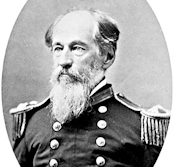Stanly believed that his outspoken criticism of several incidents involving Commodore Jones led to his persecution. When Jones was ordered to take command of the Pacific Squadron in 1848, he had been permitted to bring with him his slave, Griffin Dobson. The department "normally did not provide additional pay for servants," but Jones had been injured during the War of 1812 and "did not have full use of [an] arm."8
Several years earlier, the Navy allowed the "negro slave" to be "rated as a seaman," thus permitting him
Two months after the incident, St. Mary's sailed into the Port of San Francisco. Within hours of his arrival, Stanly was "put under arrest and to his utter amazement" he discovered it was because of a report made by Commander Johnston to Commodore Thomas ap Catesby Jones about the toothache incident. The Johnston report was, in Stanly's words, "detestable, low, and [a] degrading offence [against him and a] falsehood."6
Stanly claimed Johnston was working in concert with Jones to "oppress and injure" him. He was put on trial, and Stanly believed "every effort was made to convict him," but he was acquitted.
Shortly thereafter, Stanly's request to go-ashore on personal business was approved, provided he returned the same day. He missed the "Sunset boat," forcing him to stay in San Francisco overnight and return the next morning on the 7 a.m. boat. He claimed he was confused by the "multiplicity of new roads in San Francisco" and got lost "in a walk to a village, where the fatigue, the lateness of the hour (the consequence of getting lost), and the impossibility of getting horses" prevented him from obeying the "Sunset order."
Page 1 References 1 thru 28 see pages 3 and 4
By Daniel Demers, DrBicuspid.com contributing writer



THE WRITINGS OF
DANIEL J. DEMERS
Continued Page 2
Courtesy of:
December 30, 2013 -- In 1849, with the ship St. Mary's, part of the U.S. Navy's Pacific Squadron, lying at anchor at the port of Callao, Peru, Lt. Fabius Stanly suffered "acutely from 'neuralgia' in the face."1 He thought that removing a tooth would alleviate the pain in his face and temple. After consulting with the ship's surgeon, who agreed the experimental extraction might work but didn't have the necessary instrumentation, Stanly was told to try the surgeon aboard the Ohio, the flagship of the squadron. The surgeon there didn't have the right tool either and advised Stanly to go "on shore and have the tooth extracted [by a dentist]."5
Upon returning to the ship with the "tooth in his pocket," he was advised that the ship's commander, Zachariah F. Johnston, felt that Stanly had gone on shore without permission. He immediately called on the commander and "explained the cause and manner of his absence."3 According to Stanly, Johnston took "no exception to my explanation and he supposed it was entirely satisfactory."4
The commodore, the toothache court-martial, and Moby Dick



His commanding officer requested he put his "reasons or excuses" in writing, which he refused to do. This refusal resulted in a court-martial overseen by Jones' good friend and ally Commander Johnston; Stanly was found guilty of disobedience of orders and conduct unbecoming of an officer and a gentleman. He was sentenced to a public reprimand by Commodore Jones and his Pacific Squadron service was extended by two years.
In the public reprimand, Jones accused Stanly of twisting facts with "a parity of false reasoning and vain boasting [and] evincing a recklessness of disposition or inexcusable ignorance of his obligations to his country and to his superior in command." Stanly appealed both the guilty verdict and the reprimand to the secretary of the Navy. He alleged that Jones' reprimand "degraded his duty" by an expansive and unwarranted "caustic criticism" of him not specified under the court-martial sentence.7
Lt. Fabius Stanly
E-MAIL ME ddemers901@sonic.net

